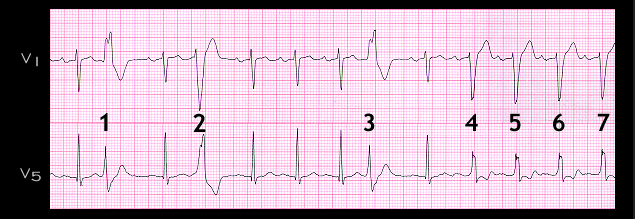
[IS IT POSSIBLE TO INSERT COUPLING INTERVALS OF THE 3 VPC’s BELOW THEM IN V5?]
The PP intervals of the consecutive sinus beats are 0.60-0.62 seconds. The first 3 wide complex beats are ventricular premature beats. They are not preceded by P waves and the P waves and QRS complexes that follow them occur at their expected times. Note that interval between the P waves of the beats that precede and follow each of these wide complex beats (1.20-1.24 seconds) is twice the PP interval of the consecutive sinus beats. Also note that the coupling interval of the second wide complex beat (0.82 seconds) is longer than that of the first and third wide complex beats (0.76 seconds) and that its waveform is different, This suggests that it is may be arising from a different ventricular location. There is a hint of a sinus P wave just before the onset of the second wide complex beat, but the sinus P waves can not be identified with the first and third wide complex beats, because they are hidden in the end of these wide QRS complexes.
The last four wide QRS complexes (beats 4-7) are each preceded by a P wave. These P waves are similar in shape to the prior sinus P waves as are their PP and PR intervals and although they are most likely sinus in origin, they are conducted aberrantly. They are discussed further on the next page.
